|
A Killer
Collection... Poison Bottles
By Mike
McLeod
Although it is hard to
pinpoint exactly when the method of making glass was discovered,
evidence suggests that it began several millennia ago. Hollow glass
artifacts do not appear in the records of world history until about
1500 B.C., although solid glass beads were known centuries earlier.
In Egypt, glass was used as part of the outer glaze in figurines and
ware from about 5000 B.C.
Initially, the process to
create hollow jars and containers from glass was labor-intensive. A
ball of clay mixed with sand or dung was formed in the shape of the
desired cavity and attached to a metal rod. The rod was inserted
into molten glass. Another technique was to draw strings of molten
glass around a clay ball until it was covered completely with
several layers. In both processes, the glass vessel had to be cooled
and reheated several times to shape it into the final
product.
A major break-through
(excuse the pun) occurred in the 1st century B.C. in Syria when
glassblowing was discovered. Glass could then be quickly blown into
different shapes and sizes. Later, molds of wood or metal were
used.
Although we think of them
as a lead or gold goblet society, the Romans actually used quite a
bit of glass. Because it was inexpensive, it became almost
commonplace among them. Emperor Gallienus, who reigned from 260 A.D.
to 268 A.D., refused to drink from glass "because nothing was more
common." Seneca, however, extolled glass, saying that fruit appeared
more beautiful in it. Indeed, a wall painting from the first century
A.D. found in a town near Pompeii shows fruit in a glass
bowl.
The Romans and other
cultures used glass containers for food, wine, perfumes, spices,
oils, sauces and medicines because it did not contaminate them with
odors. Glass also allowed the contents of jars and containers to be
identified without removing the lids.
Pick Your
Poison
One of the most beautiful
glass collectibles today is poison bottles. Most antique or vintage
poison bottles collected date from the 1870s to the 1930s. Many
people during those days were illiterate, so accidental poisonings
were a fact of life. A New York Times article dated May 11, 1913,
reported a superintendent of a Missouri hospital ordered sleigh
bells chained to the necks of bottles containing poisons after an
attendant gave carbolic acid to a patient by mistake. The patient
died, and the attendant was indicted.
Using sleigh bells, though
attention getting, was not the answer for a growing chemical
industry in the late 1800s. England was experiencing an economic
boom from the Industrial Revolution. Local chemists and druggists
found they could produce cleaning compounds, insect killers, vermin
poison, etc. cheaply enough to sell far and wide. Glass bottles,
too, were inexpensive and perfect for transporting their contents to
market, so the poison trade really began to take off.
And so did the death rate.
Both the governments of the United States and England enacted laws
to prevent accidental poisonings. However, it was the poison
manufacturers themselves who took direct action to save customers
who, for instance, were fumbling for medicine by candlelight and
grabbing bedbug poison by mistake. What they did not only reduced
the number of accidental deaths, but it also created an almost
irresistible collectible.
To distinguish them from
non-lethal products, poison bottles were made unique and dramatic in
color, texture and shape. Colors like cobalt blue, honey amber,
black, and emerald and several other shades of green were used to
ensure they stood out from the other bottles on the
shelf.
Poison bottles were also
designed with unique textures: latticework, raised ridges, dots,
diamonds, horizontal or vertical ribbing, or hobnails. Also,
embossed lettering warned, "DEATH," "POISON," "POISONOUS," or "NOT
TO BE TAKEN INTERNALLY."
Unique bottle shapes were
created to warn users of poison. F.A. Thompson & Co. made a
bottle in the shape of a coffin with "POISON" embossed on two sides.
In 1999, a 3 1/8" example sold on eBay for $775.
In England, cobalt blue
"subs" bottles were invented by H.J.W. Martin and G.W.J. Walker in
the fat cigar shape of a submarine. It features a long, vertical
neck protruding from the center of the top and is embossed "POISON."
This bottle comes in three, four, and five-inch sizes and sells for
several hundred dollars.
Another unique English
bottle was the 10 1/2 inch, 20 oz. Martin's Poison. In addition to
being very large in size and aqua in color (most manufacturers
steered away from this color because of its similarity to other
product bottles), the Martin's bottle was manufactured so it had to
lie on its side. It also has a "U" bend or indentation in the
shoulder. The horizontal direction of the bottle performed two
functions: first, it pointedly identified this as an atypical
bottle, and therefore, probably a poison; and second, the "U" bend
prevented spillage.
Owl
Bottles
In America, the Owl Drug
Company opened its doors in 1892 in San Francisco, dispensing
medicine, soda, pills and poisons in its own distinctive bottles.
The company's success led to its expansion to a dozen states. It was
eventually purchased by Rexall Drugs. But during its heyday, the Owl
Drug Company produced cobalt blue and clear bottles embossed with
its owl logo sitting on a mortar bowl. The cobalt bottles are
particular favorites with collectors. The Owl Drug Company produced
its bottles with many variations, including: one-wing owls, two-wing
owls, long tail, no tail, short tail, potbelly owl, and
more.
Joan Cabaniss, a bottle
collector and publisher of the Antique Poison Bottle Collectors
Association's newsletter, has tracked poison bottle sales on eBay
since 1999. Even so, valuing Owl bottles is difficult, as Joan
explains: "There are 10 sizes of the one-wing, cobalt, BIMAL Owl,
from one-half ounce to a 32-ounce size. Those have sold for $48 to
$64 for the one-half ounce size to $591 to $700 for the 32-ounce
bottle. The two-wing ABM bottles are in eight sizes and have sold
from $76 to $165.50."
BIMAL is the abbreviation
for blown-in, mold-applied lip. These bottles were hand made. ABM
(automatic bottle machine) bottles were made by machine. To tell one
from the other, look at the seam. On an ABM bottle, the seam runs
all the way through the lip. BIMALs have no seam in the lip because
it is added later in the process.
When Rexall purchased the
Owl Drug Co. in 1920, it stopped making Owl bottles. This was not
long after Owl Drugs had switched from BIMALs to ABMs. (Automatic
bottle-making machines were first introduced in the early 1900s.)
Ironically, Owl ABM bottles may be somewhat harder to find than the
handmade BIMALs since Rexall curtailed production not long after the
company switched over. Yet, Digger O'Dell, publisher of Poison, Drug
Store and Apothecary Bottles, believes that, "The older bottles will
bring more money. There are a couple of ABM poisons that bring big
bucks. ABM bottles may be rarer in many cases, such as the Owl
bottles, but only a few purists would place more value on
them."
Skull
Bottles
Perhaps the most recognized
symbol of death, the pirate flag's skull and crossbones, was often
used on poison labels starting in the mid-1800s. Then toward the end
of the century, the skull and crossbones was embossed on
bottles.
A bottle in the shape of a
skeleton's skull was patented in 1894 by Carlton Lewe and has become
the most famous poison bottle. Found in three sizes-from less than 3
inches to 41/2 inches in height-this very rare poison bottle sells
in the $2,000-$3,500 range, according to Reggie Lynch of Reggie's
Poison Bottle webpage (www.ipass.net/~rlynch/bottles/poison.html).
However, this bottle often has damage to the nose where the glass is
thinnest.
Rather than make a
different bottle for every product as we do today, early companies
used the same bottles for different poisons and attached a label to
identify the contents. Some companies patented the shapes of their
bottles-a sort of early brand marketing-to keep competitors from
copying their designs. Original labels in good condition on bottles
enhance their values, as do original cork stoppers and intact
contents.
Today, we often think of
poison as being a liquid. However, early poisons were more often in
tablet or pill form for ease of delivery and so it could be
reconstituted to the appropriate strength or dosage.
Manufacturers dispensed
poisons in unique shapes again as a warning to the hazard. Some
examples were tablets shaped like: a coffin with skull imprint
(mercuric chloride, Sharp & Dohme & Co., deep purple in
color, antiseptic); a triangle with "POISON" stamped on two sides
(mercury bichloride, W.R. Warner & Co., an antiseptic); white
diamond (atropine sulfate, Eli Lilly & Co., muscle
anti-spasmodic); and three-leaf clover inscribed "POISON" (mercuric
oxycyanide, Sharp & Dohme & Co., dark blue).
So-called "poisons" during
those days sometimes performed double duty as medicines. Given in
small amounts, they cured; too much, they killed. Strychnine was
used as a stimulant and a tonic, but the dose to cure and kill was
almost the same. Atropine relaxed intestinal muscles and asthma
attacks. Too much induced mental confusion and increased the heart
rate. Arsenic was used to treat syphilis and skin
diseases.
If you are interested in
conversing with collectors, visit the Antique Poison Bottle
Collectors Association website at http://www.antique.poisonbottle.com/, or write
Mary Riggin at oysterking@esva.net. If
you would like to learn more about poison bottles, you can receive
the APBCA's newsletter by sending $10 to: 312 Summer Lane,
Huddleston, VA 24104. Reference books include: Kuhn's Poison Bottle
Workbooks, Vols. I & II (3954 Perie Lane Jose, CA 95132); Digger
O'Dell's Poison, Drug Store and Apothecary Bottles, (Vol. 10), $25,
( http://www.bottlebooks.com/; 4943 Isaac Ln.,
Mason, OH 45040); Poison Bottles by Roger Durflinger.
2001
|
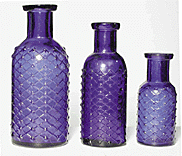
Latticework
could save your
life in the middle of the night.
(Courtesy, Digger
O'Dell)
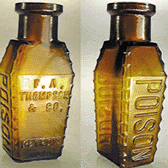
Coffin-shaped
F.A. Thompson & Co., Detroit, golden yellow amber, $750.
(Courtesy Reggie Lynch)
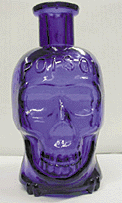
The coveted
Skull bottle comes in three sizes and has sold for $2,000-$3,500.
(Courtesy Mary Riggin)
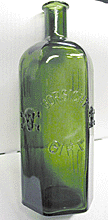
Three
warnings: "Gift" means "poison" in German; "Vorsicht" ("caution");
and the skull communicates in all
languages and to the illiterate.
(Courtesy Mary Riggin)

5 inch, 2-wing
Owl Drug Co. bottle with original label on side. (Courtesy Reggie
Lynch)
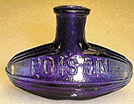
Cobalt "Subs"
bottle, $440on eBay (courtesy, Reggie Lynch)

Owl Drug Co. 9
1/2" triangular
sold for $635 on eBay.
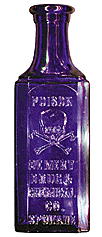
Rare DeMert
poison bottle, Spokane, WA, Randy Mitchell, owner.

Bews Pharmacy,
skull & crossbones embossed (Courtesy Digger O'Dell)
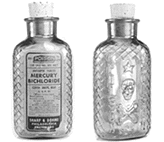
Sharpe &
Dohme latticework bottle with intact label (Courtesy Digger
O'Dell) |